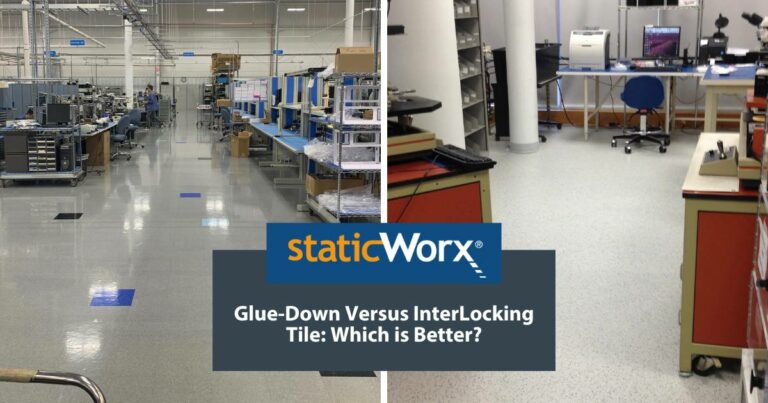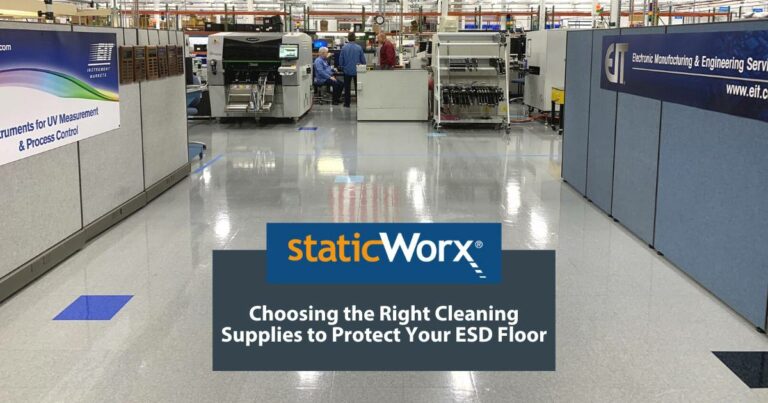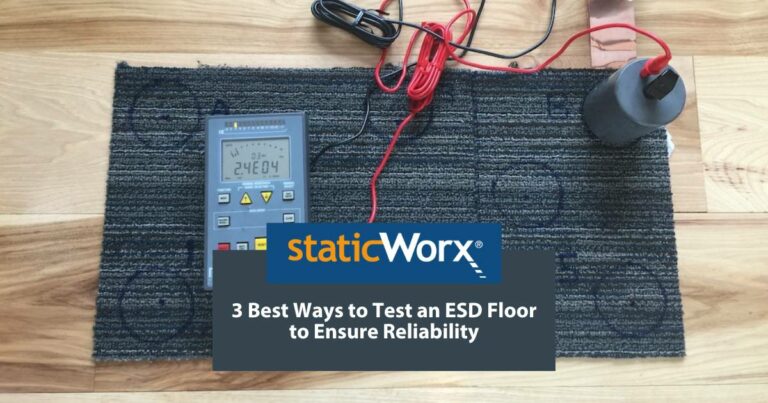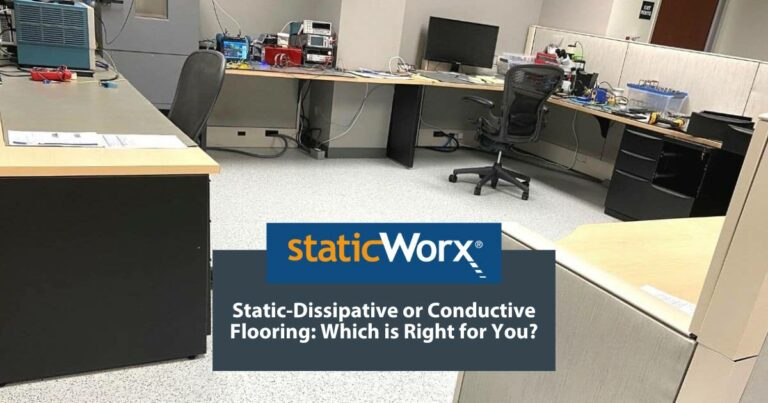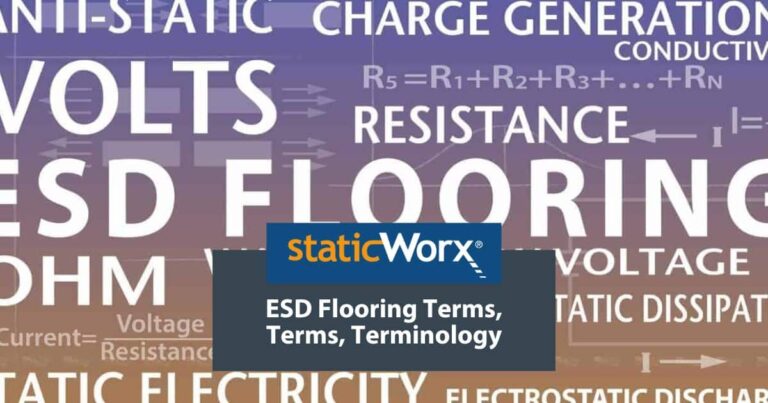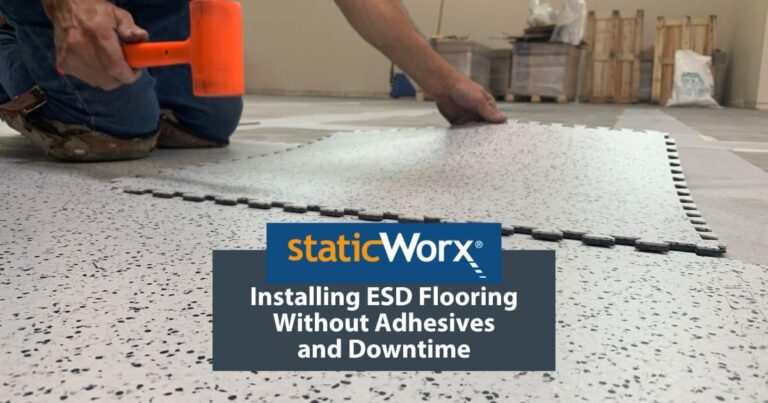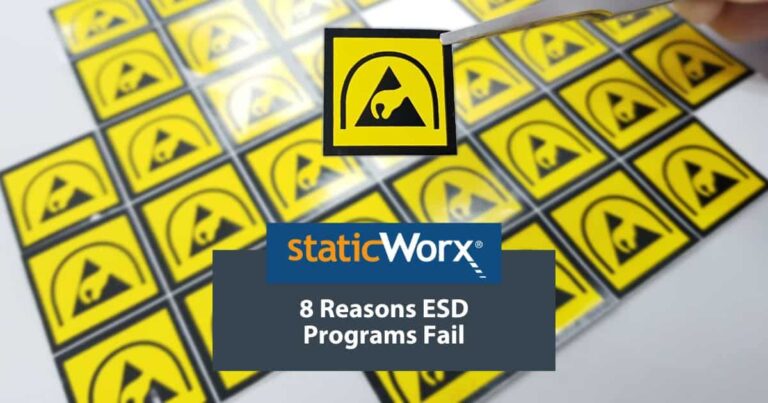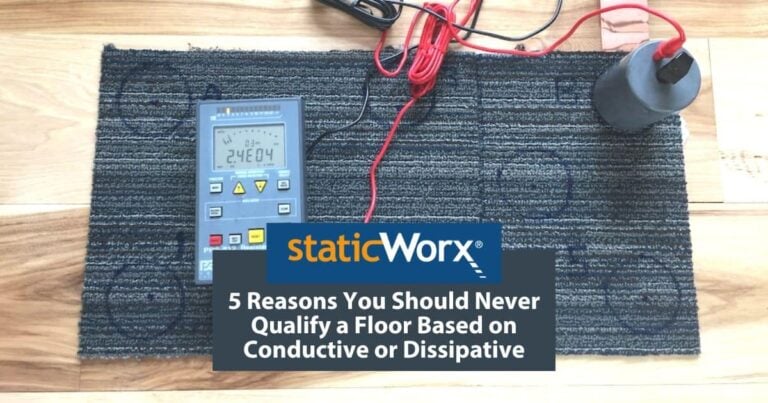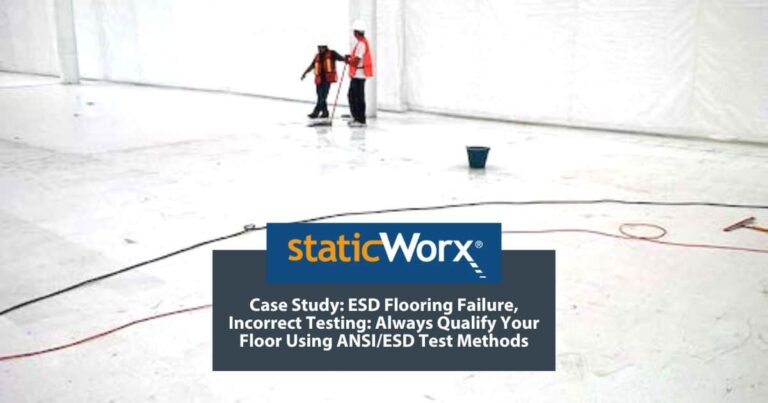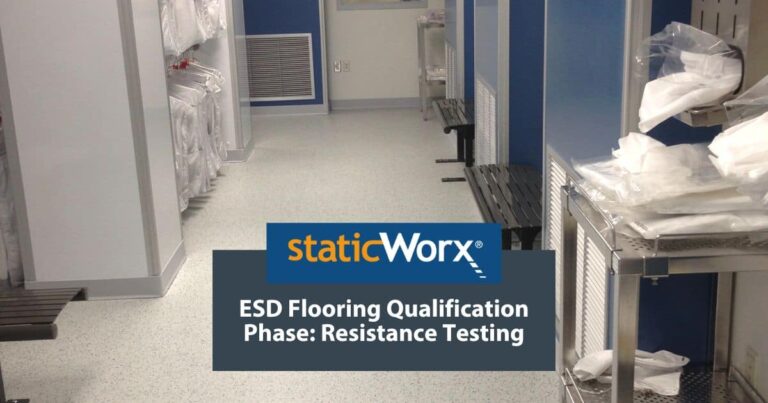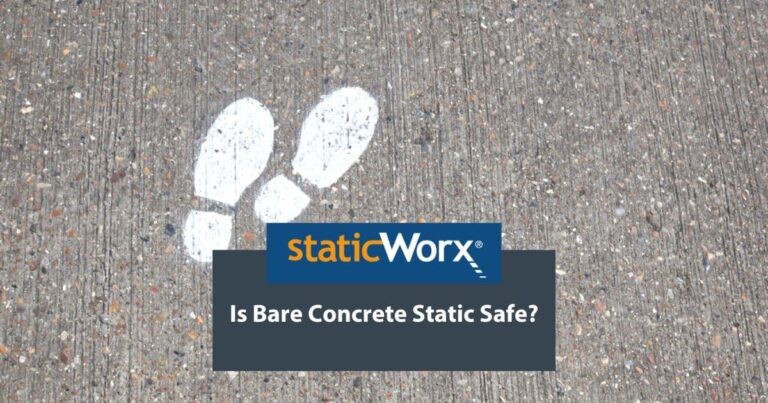Learn the differences between ESD solid vinyl tile and interlocking ESD tile. The post compares specs, installation, maintenance and intangibles.

Static-Dissipative and Conductive Flooring, How They Differ & Why It Matters
9 min read, 3 min video
Flooring is a crucial element in any industrial and commercial setting. Flooring that controls electrostatic discharge (ESD) is critical in facilities where static electricity is a concern. In these environments, conductive and static dissipative flooring can be used to protect sensitive electronic equipment from damage caused by random ESD events.
Conductive and static dissipative flooring both dissipate, or transport, static charges to ground. Used (in most cases) in conjunction with static-protective footwear, both also prevent static generation. So, what exactly is the difference? Let’s take a closer look.
Conductive Flooring
Conductive flooring is designed to prevent the buildup of static electricity by providing a pathway for electrical charges to dissipate to ground. This is achieved by embedding elements with conductivity (low electrical resistance) into the flooring material. Examples include carbon, graphite or copper. Conductive elements allow electrical charges to flow freely from their surface, through the thickness of the flooring material, to an earth ground.
Conductive flooring is often used in electronics manufacturing and handling facilities to protect the equipment and prevent manufacturing losses as well as failure in the field. It is also used in areas where there is a high risk of explosive or flammable materials, such as chemical plants, munitions factories, and oil refineries. In these settings, the buildup of static electricity can ignite a fire or explosion, putting workers and equipment at risk.
To be categorized as conductive, a material must measure under 1.0 x 10E6 ohms using an ohm meter, following procedures outlined in either ASTM F150 or ANSI/ESD STM7.1. For safety reasons, most electronics facilities shy away from using flooring materials that measure < 2.5 x 10E4.
Static-Dissipative Flooring
Like conductive flooring, static-dissipative flooring is designed to control the buildup of static electricity and dissipate charges to ground. Static-dissipative flooring transports charges at a slightly slower rate than conductive floors, with a more controlled release, while also releasing charges to an earth ground. This slower transport of electrical current is achieved by using elements with a higher electrical resistance than used in conductive flooring or by embedding a lower ratio of conductive particles in the flooring material.
Static-dissipative flooring is often used in end-user facilities that rely on sensitive electronic equipment for their core mission. These include computer rooms, labs, cleanrooms, PSAPs, communications facilities, server rooms, financial institutions, networked government offices and many more. In these settings, the buildup of static electricity can damage the equipment or cause malfunctions, leading to costly repairs, lost or missed calls, garbled signals, data loss or disruption, and facility downtime.
To be categorized as static dissipative, a material must measure between 1.0 x 10E6 and < 1.0 x 10E9 using an ohm meter, following procedures outlined in ASTM F150 or ANSI/ESD STM7.1.
Key Differences
The key difference between conductive and static dissipative flooring is the rate at which each floor allows electrical charges to flow through the material to ground. Conductive flooring allows the charge to flow more freely and quickly. Static-dissipative flooring also draws charges through the material, but more slowly, in a more controlled manner.
Another way to express the same thing is to refer to their electrical resistance. Electrical resistance is the opposite of conductivity. Conductivity measures how quickly charges flow through a material. Resistance measures the rate at which the material slows charges moving from one point to another or from the material to ground. Conductive flooring has a lower resistance, while static dissipative flooring has a higher resistance.
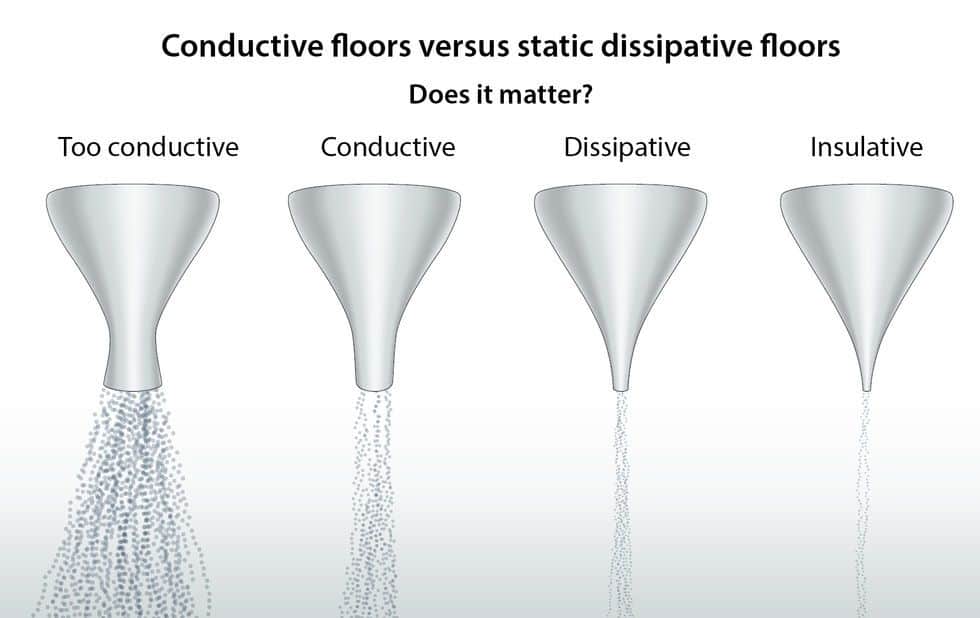
Which is Right For You?
The choice between conductive and static-dissipative flooring will depend on the specific requirements of your environment and application. When working with flammable or explosive materials, conductive flooring is the required option to ensure rapid discharge and safety. If you are working in an end-user facility that relies on sensitive electronic systems, you don’t need the floor to be too conductive. Static-dissipative flooring, carpet specifically, may be a more suitable option since it measures in the range recommended by organizations like FAA, ATIS and other organizations that set communications industry standards.
Is the Floor Antistatic? Hint: Conductive is Not the Same as Antistatic
Conductivity – or static dissipation – is not the only property to consider when purchasing a floor to protect your electronic equipment or prevent explosions. You must also consider whether or not the floor is antistatic. That is, can the floor prevent charge generation in the first place? Conductivity and charge generation are not the same thing. A floor can be conductive, even highly conductive, and still generate static.
Some floors, ESD vinyl and epoxy in particular, do not prevent static unless they are used in conjunction with special ESD footwear. This means, every person walking through the facility must wear ESD-protective heel straps, toe straps, sole straps or ESD shoes. Otherwise the floor will not protect equipment from damage as effectively as other options such as SD carpet and EC rubber.


Before selecting an ESD floor, users and specifiers should ask questions about the application, the environment and objectives of facilities managers and owners. Questions include:
- What are the industry standards for this application?
- What are the stakes and risks if an ESD event occurs?
- Will everyone in your facility wear ESD footwear?
- What happens if ESD footwear compliance is an issue?
- Do you have the resources to enforce a mandate requiring ESD footwear?
These questions, and not just electrical resistance (if the floor is conductive or static dissipative), should enter into the decision about which ESD flooring to use.
When selecting ESD flooring, it is important to work with a qualified flooring expert, who can help you determine the right solution. Electrical standards vary across industries and applications. An ESD flooring expert can help you understand the electrical standards for your industry and application. They’ll assess any risks and requirements, including floor prep and usage requirements – e.g., will you be using harsh chemicals? Rolling heavy loads or using fork lifts? And they’ll evaluate ergonomic concerns such as slip resistance or sound attenuation. Taking all of this into consideration, an ESD flooring expert will recommend the ESD flooring option that will best meet your needs and objectives.
About StaticWorx, Inc
All StaticWorx posts are written by our technical team and based on industry standards and specifications, test data, independent lab reports and other verifiable data. We provide ESD training and offer CEU credits to architects. If you’re interested in an ESD training session or architects’ ESD workshop, give us a call: 617-923-2000.
Get in Touch
The form below will help us better understand your needs and get you as quickly as possible to the right person. We look forward to helping you solve your static problem!
You can expect a response within 24 hours. For faster service, please give us a call: 617-923-2000
"*" indicates required fields
Visit our privacy policy to find out how we process data.
More Blog Posts
To maintain performance, ESD floors require specially formulated products. We offer tips on what to consider when choosing cleaning supplies.
Static-dissipative floors transport harmful static charges to ground. Dissipative is also a term for flooring with a specific, measurable electrical resistance.
StaticWorx recognized as one of the fastest growing private companies in the U.S. 2023 marks StaticWorx fourth appearance on Inc. 5000 list.
We explain the 3 main ways to test an ESD floor: Electrical resistance; body voltage & ESD audits, with advantages and reasons for each.
Three critical factors—application, industry standards & footwear—help you choose the best ESD floor, while ensuring the safety & efficiency of your operations.
StaticWorx Founder and President Dave Long shares three of his recommended reads: Quit, How to Change, and The Goal.
There are leadership qualities StaticWorx strives to embody every day, with every product, throughout each project.
No matter how you slice and dice a project, an ESD floor is a major investment. This blog post examines five ways to keep undue costs down.
What’s the difference between static control and static resistant? Or anti-static flooring? Find out more in our blog post.
A major part of any ESD control program is getting proper flooring in place. How can one replace a floor without generating any debris? Learn more.
A well-designed, comprehensive, fully realized program is a must for manufacturers serious about ESD control. Learn why ESD programs fail.
ESD Floors should never be specified based on the descriptive terms conductive or static dissipative. Always base ESD specs on verifiable metrics. Find out why.
To comply with relevant ESD standards, test electrical properties using methods outlined in ESD S20.20. For best results require testing by an independent lab.
If the vapor barrier fails to adhere to the subfloor, tiles will lift. Bond test and manufacturer oversight are crucial to ESD floor installation success.
Blog Post: Conductive and Static-Dissipative Flooring: What’s the Difference?
The Layperson’s Answer
What’s the difference between conductive and static-dissipative flooring? Facts, analogies and images illustrate the difference in easily understood terms.
Qualifying an ESD floor helps ensure you get the floor you paid for. Find out why you should always qualify according to ESD S20.20
Qualification is the first step in selecting an ESD floor. Learn how to perform resistance tests to be sure the floor meets electrical & safety standards.
Will bare concrete control static? Learn why concrete floors are unreliable & what precautions to take if you must work on a bare concrete floor.
A look at how the StaticWorx cartoon, 'Conductive Flooring Does Not Mean Antistatic Flooring,' was conceived and created.
Learning Center Articles
- ESD Basics
- Installation & Maintenance
- Selecting & Specifying an ESD Floor
- Technical Information
- 7 Common Mistakes Selecting an ESD floor
- A Guide to ESD Flooring Selection
- Avoid Costly Failures: What You Need to Know When Specifying ESD Flooring
- Choosing ESD Flooring for:
- ESD Footwear: What Is It and When Is It Necessary?
- ESD Footwear for Electronics Manufacturing and Handling Applications
- Facility Managers’ Guide to Selecting ESD Flooring
- The Need for Due Diligence in Specifying Static-Free Flooring
- Standard of Care for Specifying Floors in Mission-Critical Spaces
- Understanding the Hidden Costs of ESD Flooring

StaticWorx high-performance static-control floors protect electronic components, explosives, and high-speed computers from damage caused by static electricity. ESD flooring is part of a system. Choices should always be based on objective, researched evidence. When you partner with us, we look at all possible items that may need to integrate with the floor, and, focusing on your goals and objectives, help you find the right floor for your application.




